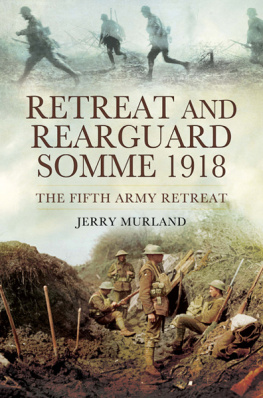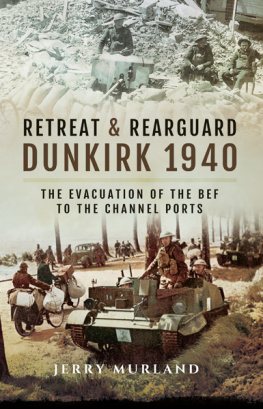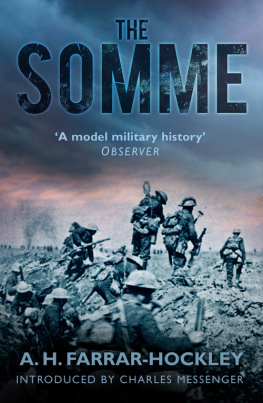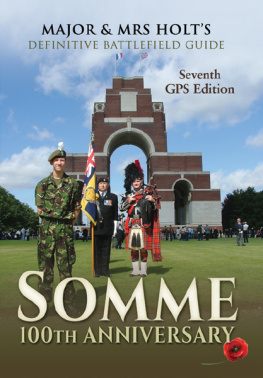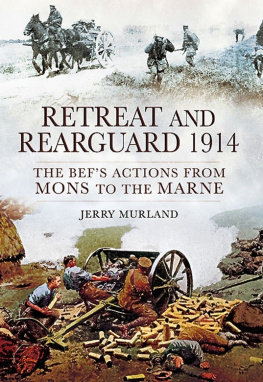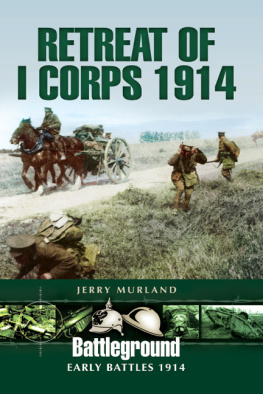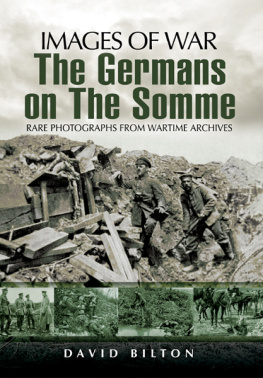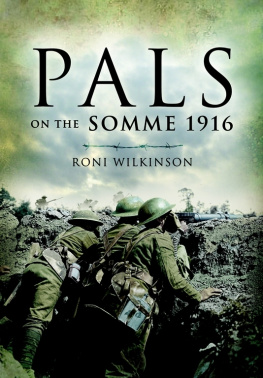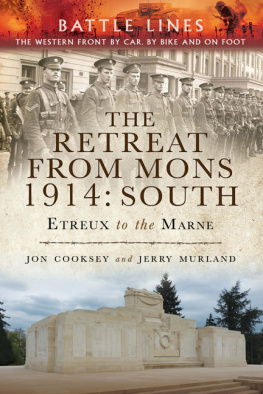Murland - Retreat and rearguard - Somme 1918
Here you can read online Murland - Retreat and rearguard - Somme 1918 full text of the book (entire story) in english for free. Download pdf and epub, get meaning, cover and reviews about this ebook. City: France, year: 2014, publisher: Pen & Sword Military, genre: History. Description of the work, (preface) as well as reviews are available. Best literature library LitArk.com created for fans of good reading and offers a wide selection of genres:
Romance novel
Science fiction
Adventure
Detective
Science
History
Home and family
Prose
Art
Politics
Computer
Non-fiction
Religion
Business
Children
Humor
Choose a favorite category and find really read worthwhile books. Enjoy immersion in the world of imagination, feel the emotions of the characters or learn something new for yourself, make an fascinating discovery.
Retreat and rearguard - Somme 1918: summary, description and annotation
We offer to read an annotation, description, summary or preface (depends on what the author of the book "Retreat and rearguard - Somme 1918" wrote himself). If you haven't found the necessary information about the book — write in the comments, we will try to find it.
Murland: author's other books
Who wrote Retreat and rearguard - Somme 1918? Find out the surname, the name of the author of the book and a list of all author's works by series.
Retreat and rearguard - Somme 1918 — read online for free the complete book (whole text) full work
Below is the text of the book, divided by pages. System saving the place of the last page read, allows you to conveniently read the book "Retreat and rearguard - Somme 1918" online for free, without having to search again every time where you left off. Put a bookmark, and you can go to the page where you finished reading at any time.
Font size:
Interval:
Bookmark:

To Alisha
who accompanied me on a journey along the Fifth Army front in August 2013
First published in Great Britain in 2014 by
Pen & Sword Military
an imprint of
Pen & Sword Books Ltd
47 Church Street
Barnsley
South Yorkshire
S70 2AS
Copyright Jerry Murland 2014
ISBN 978 1 78159 267 0
eISBN 9781473838376
The right of Jerry Murland to be identified as the Author of this Work has been asserted by him in accordance with the Copyright, Designs and Patents Act 1988.
A CIP catalogue record for this book is available from the British Library
All rights reserved. No part of this book may be reproduced or transmitted in any form or by any means, electronic or mechanical including photocopying, recording or by any information storage and retrieval system, without permission from the Publisher in writing.
Typeset in Ehrhardt by
Mac Style, Bridlington, East Yorkshire
Printed and bound in the UK by CPI Group (UK) Ltd, Croydon,
CRO 4YY
Pen & Sword Books Ltd incorporates the imprints of Pen & Sword Archaeology, Atlas, Aviation, Battleground, Discovery, Family History, History, Maritime, Military, Naval, Politics, Railways, Select, Transport, True Crime, and Fiction, Frontline Books, Leo Cooper, Praetorian Press, Seaforth Publishing and Wharncliffe.
For a complete list of Pen & Sword titles please contact
PEN & SWORD BOOKS LIMITED
47 Church Street, Barnsley, South Yorkshire, S70 2AS, England
E-mail: enquiries@pen-and-sword.co.uk
Website: www.pen-and-sword.co.uk
Contents
Authors Note
T he basic formation of the British Army in the Great War began as it still does today with the infantry platoon. Commanded usually by a second lieutenant or lieutenant and assisted by a platoon sergeant it was divided into four sections each commanded by a corporal or lance corporal. There were generally four platoons in a company, all of which answered to a company commander. In 1918 it was not unusual for companies to be commanded by senior lieutenants. Four companies and a headquarters company made up an infantry battalion, commanded by a major or lieutenant colonel. Within the headquarters company was the second-in-command, the battalion adjutant the commanding officers right-hand man the regimental sergeant major and the battalion quartermaster. Usually the battalion medical officer was part of this group. The average strength of a battalion in 1914 was approximately 900 officers and men, by March 1918 a large proportion of battalions in the front line had been reduced to more or less 550 officers and men.
The next unit of command after the battalion was the infantry brigade, initially made up of four battalions but reduced to three in February 1918 and commanded by a brigadier general. A division consisted of at least three brigades and was under the command of a major general. Beyond that, divisions were organized into corps which were usually commanded by lieutenant generals and grouped together to form armies. The Fifth Army was one such formation. On the Western Front in March 1918 there were five British and Commonwealth army groups present along the front line, all under the direction of Sir Douglas Haig, the Commander-in-Chief.
When describing the locations of units I have occasionally referred to modern day road numbering in order to give the reader using current maps of the area a more precise location. While some of the abbreviations in the text are self explanatory others require explanation. I have used a form of abbreviation when describing battalion formations, thus after its first mention in the text the 2nd Battalion Royal Munster Fusiliers becomes 2/Munsters or more simply the Munsters. Similarly infantry brigades are denoted by cardinal numbers, the 25th Infantry Brigade becoming 25 Brigade. So as not to cause confusion between a brigade of infantry and one of artillery I have simply added the word artillery.
German Army units are a little more complex. Within the infantry regiment there were three battalions each approximately the size of a British battalion and a machine gun-company. Each battalion was denoted by a Roman numeral and occasionally adopted the name of its commanding officer, where this appears in German accounts the battalions name is identified in brackets. The four companies of riflemen were given an Arabic numeral, for example, 3 Kompanie and the machine-gun company was numbered separately, adopting the battalion number. Again, I have abbreviated when describing these units, thus Infantry Regiment 31 becomes IR 31 while the second battalion within that regiment is abbreviated to II/IR 31. Within this description there are a number of other variations that appear in the text:
| FAR | Field Artillery Regiment |
| GR | Grenadier Regiment |
| RIR | Reserve Infantry Regiment |
| ID | Infantry Division |
Equivalent German and British ranks referred to in the text are as follows:
| Colonel | Oberst |
| Lieutenant Colonel | Oberstleutnant |
| Major | Major |
| Captain | Hauptmann |
| Lieutenant | Oberleutnant |
| Second Lieutenant | Leutnant |
| Corporal | Unteroffizier |
| Lance Corporal | Gefreiter |
| Private | Grenadier/Jger/Musketier/Artillerist/Kanoniere |
Acknowledgements
I n searching for personal accounts written by the men who fought in the March retreat I have scoured archive collections across the country and it is to those archivists, librarians and keepers of collections that I am most indebted. The National Archives at Kew has been a continual source of material, particularly in respect of regimental war diaries and the hugely rich source of letters and accounts that flowed between veterans and the Army Historical Branch post 1918. These accounts, apart from revealing what exactly took place and where, have provided a fascinating insight into the true nature of the fighting at a tactical level. Other sources of material have been found in the Imperial War Museum document and sound archive collections, the Liddell Hart Centre for Military Archives and the Liddle Collection at Leeds. My thanks must also go to the curators of the various regimental museums which still hold material relating to the March retreat. Of these I am particularly grateful to the Rifles Museum at Winchester and the Royal Engineers Museum, Library and Archive.
I am also indebted to Nigel Lutt at the Bedfordshire and Luton Archive, the staff at the Surrey History Centre, the Hampshire Records Office and the Leicestershire and Rutland Record Office. Special thanks must go to Laura Dimmock and Tony Pilmer at the RUSI library in Whitehall who have responded so promptly to my many requests for obscure and out of print volumes. The library which must rank as one of the best military libraries in the country holds copies of practically every defence review and military journal ever published, a place where one can easily lose track of time!
In gathering information I am also indebted to the host of individuals who responded to my online requests via the Great War Forum, a number of whom went out of their way to help by providing me with material. Adam Llewellyn, Chris Baker, Colin Taylor, Mark Smith, Jim Ainslie, Martin Mcneela, Al Grey, Andy Pugh and Dave Risley were in particular of immense help. Thanks must also go to Damien Burke at the Irish Jesuit Archive in Dublin for providing a copy of the Father Henry Gill diaries and permission to quote from them.
Font size:
Interval:
Bookmark:
Similar books «Retreat and rearguard - Somme 1918»
Look at similar books to Retreat and rearguard - Somme 1918. We have selected literature similar in name and meaning in the hope of providing readers with more options to find new, interesting, not yet read works.
Discussion, reviews of the book Retreat and rearguard - Somme 1918 and just readers' own opinions. Leave your comments, write what you think about the work, its meaning or the main characters. Specify what exactly you liked and what you didn't like, and why you think so.

